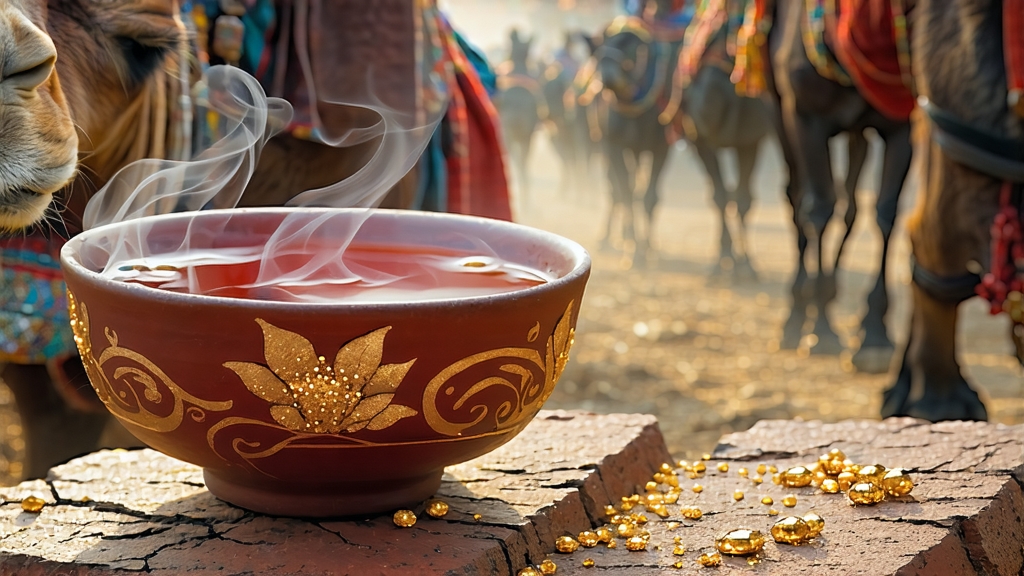
Few beverages can claim to have been both currency and medicine, yet Fu brick tea—one of the most celebrated styles of Chinese dark tea (hei cha)—carried both roles along the ancient Silk Road. Compressed into neat, chocolate-brown rectangles and prized for the tiny golden speckles that bloom across its surface, Fu brick is a living relic of caravan commerce, Tibetan monks, and imperial frontier policy. Today it is experiencing a renaissance among sommeliers who value its mellow sweetness, probiotic complexity, and remarkable ability to steep a dozen times without tiring. This article invites international drinkers to discover why Fu brick is often called “the tea that travels better than the people who carry it.”
-
Historical footprints
The story begins in the 1368–1644 Ming dynasty, when the court mandated that Hunan, Shaanxi and Sichuan provinces supply compressed tea to the horse-trading markets on the northwestern frontier. Caravans carrying coarse summer leaves from Anhua County (Hunan) discovered that the humid Qinling mountain passes encouraged a spontaneous yellow mold inside the bricks. Rather than ruining the tea, the mold—later identified as Eurotium cristatum—imparted a piney, fruity aroma and mellowed the rough leaf. Tibetan, Mongolian and Uyghur buyers paid premium prices for these “golden-flower” (jin hua) bricks, believing they eased digestion of yak-butter meals and countered altitude sickness. By the Qing era, imperial edicts fixed the weight of each brick at 2.25 kg and stamped them with official seals, turning tea into legal tender. In 2010 the FAO recognized Anhua dark tea as a China-origin protected product, cementing Fu brick’s pedigree. -
Terroir and leaf grade
Authentic Fu brick starts with late-season leaves from the Yuntaishan micro-region, 600–800 m above sea level. Morning mist, sharp diurnal shifts and granite-rich soils stress the tea bushes, concentrating polyphenols and amino acids. Only the 3rd–5th mature leaves are picked; the tougher fibers resist the 30-day piling process better than tender buds. After plucking, the leaf is briefly withered, then fixed at 160 °C to halt oxidation—unlike shou puerh, Fu brick is not fully oxidized before fermentation, leaving room for microbial actors to sculpt flavor later. -
Crafting the golden flower
The transformation from leafy mulch to aromatic brick is a choreography of moisture, heat and microbiology.
Step 1: First piling (primary fermentation)
Leaves are sprayed to 30 % moisture, heaped 70 cm high and covered with wet cloth. Temperature climbs to 55 °C within 24 h; thermophilic bacteria convert proteins into sweet amino acids while catechins begin to polymerize.
Step 2: Rolling & screening
A 30-min machine roll ruptures cells, releasing sugars that will feed Eurotium. Through a 6 mm mesh, stems and dust are removed to ensure even brick density.
Step 3: Secondary moistening
The leaf is lightly steamed for 8 s, just enough to soften it for compression without killing surface microbes.
Step 4: Compression
Traditional stone molds weigh 30 kg and require three men to operate; modern hydraulic presses exert 50 t of force for 3 s, yielding a 2 kg brick with 1.2 g cm⁻3 density—tight enough to travel on horseback yet porous enough for oxygen.
Step 5: Golden-flower flowering
Bricks are stacked on bamboo racks inside a 28 °C, 75 % RH cellar for 7–10 days. Eurotium cristatum spores, omnipresent in the aging rooms, germinate and form yellow cleistothecia. Masters monitor CO₂ levels; too high and unwanted molds invade, too low and the flowers fail to “bloom.” When the golden dots cover 30–50 % of the brick’s cross-section, the tea is moved to drying.
Step 6: Slow drying & resting
Bricks rest at 45 °C for 48 h to reduce moisture to 9 %, then age in ventilated warehouses for a minimum of one year. During this time lipids oxidize, yielding notes of walnut and dried apricot, while theaflavins complex into theabrownins, deepening the liquor color.
- Variations within Fu brick
Although “Fu” originally referred to bricks produced in Jing